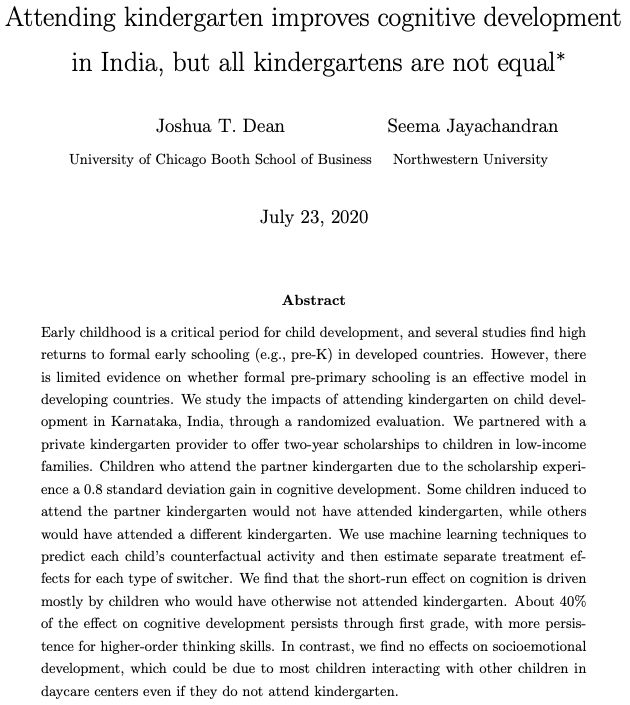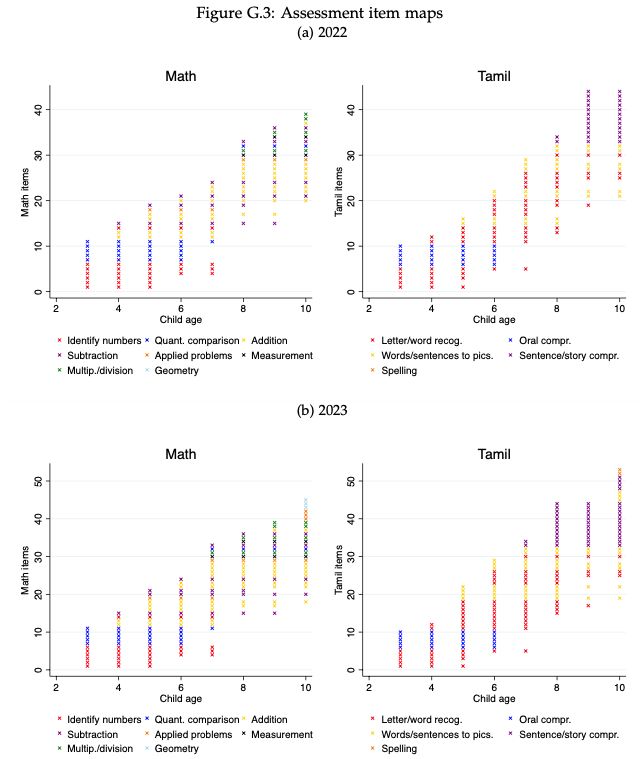

(See "experiment at scale" by @karthik-econ.bsky.social Paul Niehaus)

(See "experiment at scale" by @karthik-econ.bsky.social Paul Niehaus)


• 1,000 got training + guide
• 1,000 got training + guide + risk list
• 1,000 got training + guide + risk list + nudges
• 1,000 were controls.
Schools were spread nationwide, making this one of the largest dropout-prevention RCTs.

• 1,000 got training + guide
• 1,000 got training + guide + risk list
• 1,000 got training + guide + risk list + nudges
• 1,000 were controls.
Schools were spread nationwide, making this one of the largest dropout-prevention RCTs.




RCTs: See work by Ganimian @karthik-econ.bsky.social and Walters on improving AWCs; by @joshtdean.bsky.social @seema.bsky.social on vouchers for private preschool
Facts: See ASER Centre Early Years and main ASER Reports




RCTs: See work by Ganimian @karthik-econ.bsky.social and Walters on improving AWCs; by @joshtdean.bsky.social @seema.bsky.social on vouchers for private preschool
Facts: See ASER Centre Early Years and main ASER Reports
Why?
Maybe public sector quality induces better performance from the private sector (as Tahir, Bau,Das @nkarachiwalla.bsky.social and Khwaja find in Pakistan)?


Why?
Maybe public sector quality induces better performance from the private sector (as Tahir, Bau,Das @nkarachiwalla.bsky.social and Khwaja find in Pakistan)?
In primary schooling, this is more variable across geographies.
(Doing this correctly needs Bayesian shrinkage; details in paper)

In primary schooling, this is more variable across geographies.
(Doing this correctly needs Bayesian shrinkage; details in paper)
By contrast, private primary schools have NO positive value-added over government schools in these subjects (we did not test English)

By contrast, private primary schools have NO positive value-added over government schools in these subjects (we did not test English)



Public: Mostly anganwadi centres. Free to attend, only 1 worker + 1 helper. In TN, ~38 mins/day on cognitive tasks.
Private: Nursery/KG, often linked to primary sch. Fee-charging, focus on early learning.

Public: Mostly anganwadi centres. Free to attend, only 1 worker + 1 helper. In TN, ~38 mins/day on cognitive tasks.
Private: Nursery/KG, often linked to primary sch. Fee-charging, focus on early learning.

1) Only care about main effects? Drop the interaction cells and boost N in treatment/control
2) Want interactions? Power the study to detect them
3) Still running the short model? Specify that the effect you’ll report is a weighted average

1) Only care about main effects? Drop the interaction cells and boost N in treatment/control
2) Want interactions? Power the study to detect them
3) Still running the short model? Specify that the effect you’ll report is a weighted average
Nearly-optimal tests (onlinelibrary.wiley.com/doi/abs/10.3...) that target power near β₁₂ = 0 while guarding size.
Bias-aware CIs (arxiv.org/abs/2012.14823) or bounds (tinyurl.com/5n86u6a6, tinyurl.com/56mcxe2a) that incorporate credible limits on |β₁₂|


Nearly-optimal tests (onlinelibrary.wiley.com/doi/abs/10.3...) that target power near β₁₂ = 0 while guarding size.
Bias-aware CIs (arxiv.org/abs/2012.14823) or bounds (tinyurl.com/5n86u6a6, tinyurl.com/56mcxe2a) that incorporate credible limits on |β₁₂|








